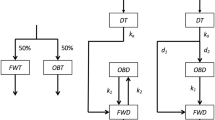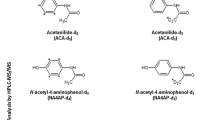Abstract
The fate of (14C)-2-ethylhexyl acrylate was studied in adult male Wistar rats given an intravenous (i.v.) or intraperitoneal (i.p.) injection of 10 mg/kg (0.054 mmol/kg). The elimination of radioactivity from blood was bi-exponential, irrespective of the route of (14C)-2-EHA administration or the age (weight) of the rats. The first phase half-lives after i.v. and i.p. administration in 4-month-old rats were 30 and 60 min, in 7-month-old rats 115 and 130 min, respectively. The corresponding values for the slow-phase were 5 and 6 h, and 14 and 14h. Elimination of the radioactivity from tissues followed a pattern similar to that seen for blood. More than half of the administered radioactivity was exhaled as carbon dioxide. Exhalation of unchanged (14C)-2-EHA accounted for only 0.05% (i.v.) or 0.3% (i.p.) of the initial dose of radioactivity. The radioactivity excreted in the urine within the first 24 h posttreatment accounted for 7% (i.p.) or 14% (i.v.) of the initial dose, and only 2% was excreted as thioethers.
Similar content being viewed by others
References
Chesnokova NP, Bersudskii SO, Brill GE, Kudin GB, Morrison VV, Otdelnova NN, Sokolova NA, Shenkman BZ (1979a) Effect of 2-ethylhexyl acrylate administered orally on animals. Gigienich Aspekty Okhrany Okruzh Sredy, Saratov, 61–64
Chesnokova NP, Bersudskii SO, Brill GE, Gorbacheva NI, Kudin GB, Morrison VV, Otdelnova NN, Sokolova NA, Shenkman BZ (1979b) Toxicological evaluation of the effect of 2-ethylhexyl acrylate administered percutaneously. Gigienich Aspekty Okhrany Okruzh Sredy, Saratov, 64–67
Cikrt M, Vodička P, Sapota A, Gut I, Stiborová A, Kopecký J (1986) Biliary excretion and organ distribution of (14C)-radioactivity after (14C)-22-ethylhexyl acrylate administration in rats. J Hyg Epidemiol Microbiol Immunol 30: 36–40
Crout DHG, Lloyd EJ, Singh J (1982) Metabolism of methyl methacrylate: Evidence for metabolism by the valine pathway of catabolism in rat and in man. Xenobiotica 12: 821–829
Delbressine LPC, Seutter-Berlage F, Seutter E (1981) Identification of urinary mercapturic acids formed from acrylate, methacrylate and crotonate in the rat. Xenobiotica 11: 241–247
Environmental Health Criteria 28 — Acrylonitrile. World Health Organization, Geneve, 1983
Environmental Health Criteria 49 — Acrylamide. World Health Organization, Geneva, 1985
Gut I, Kopecky J, Nerudová J (1981) Relationship between acrylonitrile biotransformation, pharmacokinetics, and acute toxicity. A short review. G Ital Med Lav 3: 131–136
Hashimoto K, Aldridge WN (1970) Biochemical studies on acrylamide, a neurotoxic agent. Biochem Pharmacol 19: 2591–2604
Kopecký J, Gut I, Nerudová J, Zachardová D, Holeček V, Filip J (1980) Acrylonitrile metabolism in the rat. Arch Toxicol, Suppl 4: 322–324
Kopecký J, Linhart I, Štiborová A, Šmejkal J (1985) Biotransformation of acrylic acid esters in the rat. I. Formation of mercapturic acids and their determination in urine. Pracov Lék 37: 126–129
Miller RR, Ayres JA, Rampy LW, McKenna MJ (1981) Metabolism of acrylate esters in rat tissue homogenates. Fundam Appl Toxicol 1: 410–414
Miller MJ, Carter DE, Sipos IG (1982) Pharmacokinetics of acrylamide in Fischer-344 rats. Toxicol Appl Pharmacol 63: 36–44
NIOSH 1978. Registry of Toxic Effects of Chemical Substances. In: Lewis RJ, Tatken RL (ed) (US Dept Health Educ Welfare, P. H. S., Jan. 1979)
Seutter-Berlage F, Selten GCM, Oostendorp SGML, Hoog Antink JMT (1979) The modified thioether test. In: Strik JJTWA, Koeman JH (eds) Chemical porphyria in man. Elsevier, North Holland, pp 233–236
Silver EH, Murphy SD (1981) Potentiation of acrylate ester toxicity by prior treatment with the carboxylesterase inhibitor triorthotolyl phosphate (TOTP). Toxicol Appl Pharmacol 57: 208–219
Simon P, Filser JG, Bolt HM (1985) Metabolism and pharmacokinetics of vinyl acetate. Arch Toxicol 57: 191–195
Stott WT, McKenna MJ (1985) Hydrolysis of several glycol ether acetates and acrylate esters by nasal mucosal carboxylesterase in vitro. Fundam Appl Toxicol 5: 399–404
Vodička P, Gut I, Vodičková L (1985) Effects of methyl acrylate, ethyl acrylate, 1-butyl acrylate, 2-ethylhexyl acrylate, acrylonitrile and acrylic acid in rats: elimination of thioethers and effects on blood glucose level. Pracov Lék 37: 209–215
Author information
Authors and Affiliations
Rights and permissions
About this article
Cite this article
Gut, I., Vodička, P., Cikrt, M. et al. Distribution and elimination of (14C)-2-ethylhexyl acrylate radioactivity in rats. Arch Toxicol 62, 346–350 (1988). https://doi.org/10.1007/BF00293621
Received:
Revised:
Accepted:
Issue Date:
DOI: https://doi.org/10.1007/BF00293621




